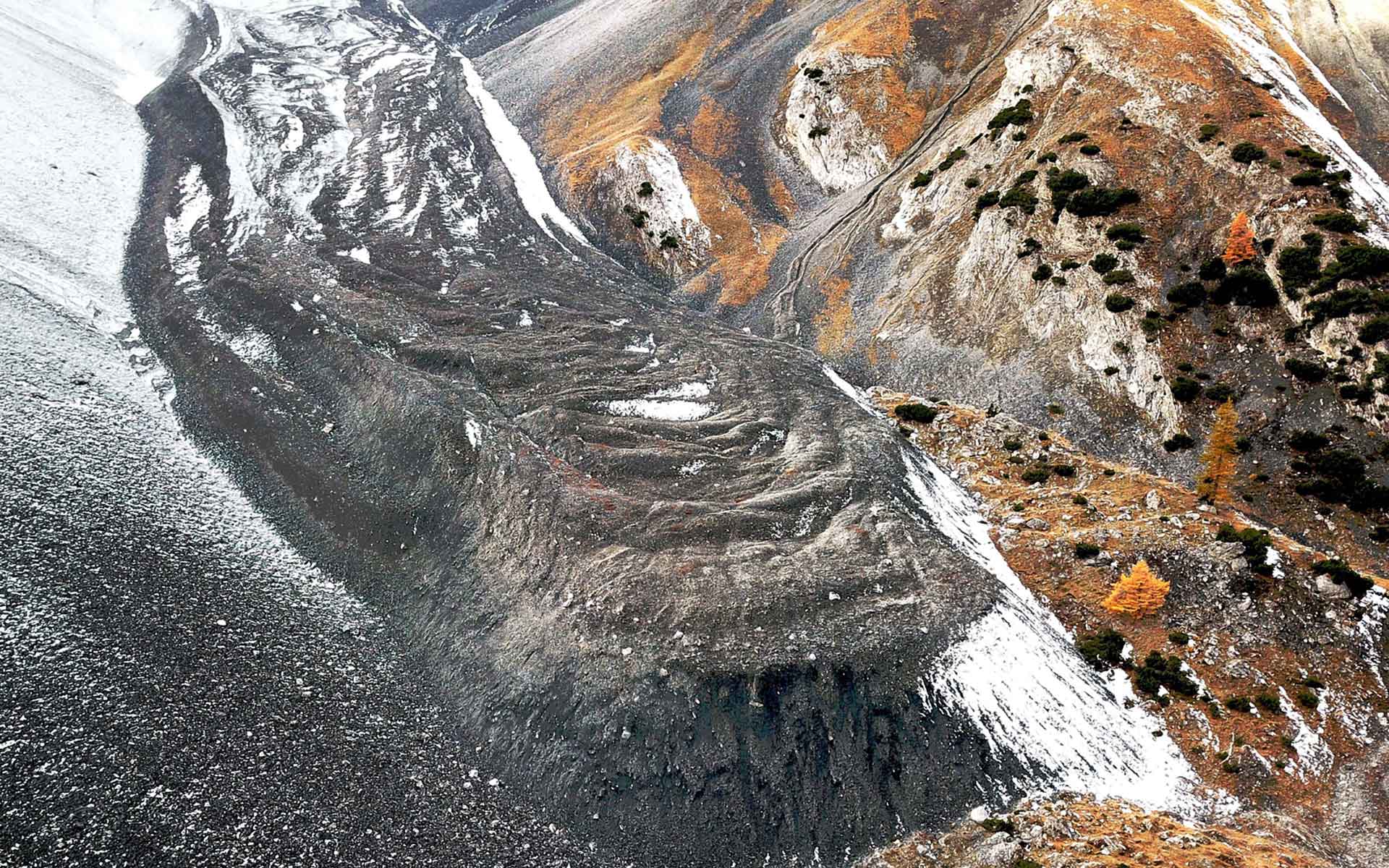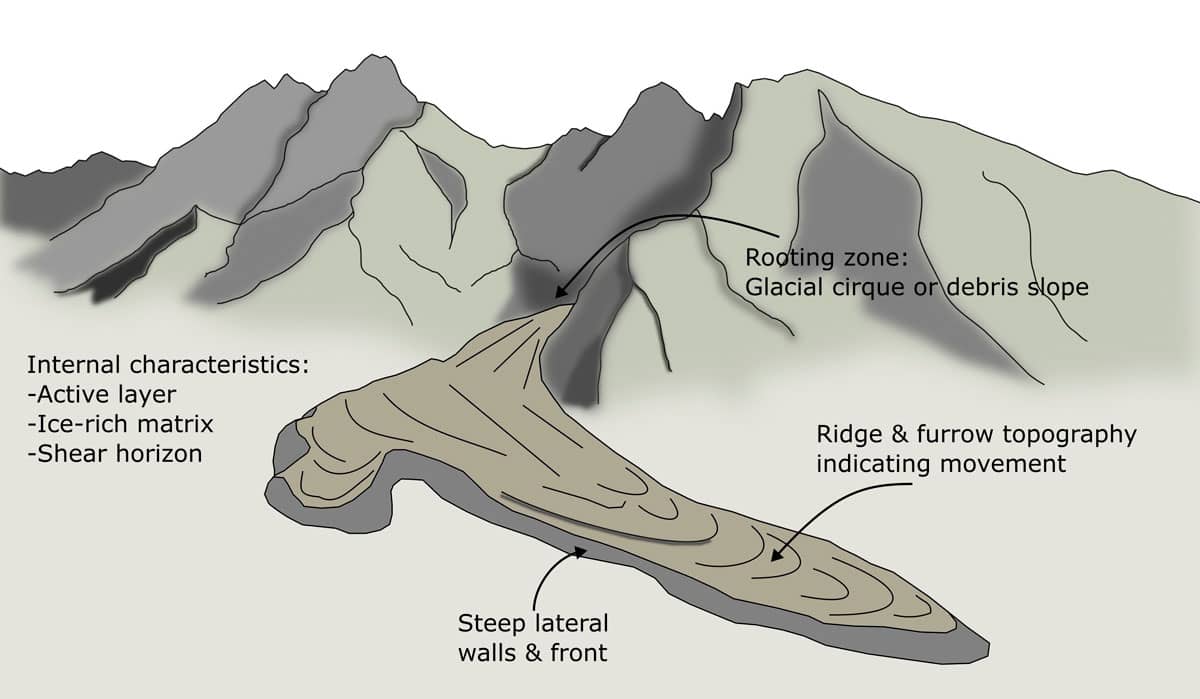
View of Val dall’Acqua rockglacier from drone (photo: A. Cicoira, autumn 2019).
Geological Period
Quaternary / Holocene
Main geological interest
Geomorphology and active geological processes
Location
Engadine / Canton Graubünden, Switzerland.
46°25’43.0″N, 9°49’20.0″E
View of Val dall’Acqua rockglacier from drone (photo: A. Cicoira, autumn 2019).
DUE TO CONTINENTAL CLIMATE CONDITIONS, HIGH ELEVATION AND HIGH WEATHERING RATES, THE ENGADINE IS ONE OF THE ROCKGLACIER HOTSPOTS IN THE WORLD AND THE HOME OF RESEARCH ON ROCKGLACIERS.
The Engadine is a reference place for mountain permafrost research, in particular rockglaciers. The Val da l’Acqua and Val Sassa rockglaciers movements have been investigated for nearly one century (Chaix, 1923). Movement rates – quantified by repeated measurements of painted stone lines – were described for the first time in 1923. Murtèl/Corvatsch is a key locality where the internal structure of rockglaciers and permafrost creeping have been investigated since the mid-1970s. Several drilling and intensive geophysical surveys in both Murtèl/Corvatsch and Muragl rockglaciers make them key localities for mountain permafrost research and longterm monitoring.
- Geological description
The Engadine is one of the rockglacier hotspots in the European Alps with a large number of rockglaciers in all states of activity (active, inactive, relict), indicating the former and present occurrence of discountinuous permafrost (Gärtner-Roer and Hoelzle, 2021). The proposed geosite is made of four specific rockglaciers representing various features of permafrost creeping: the Val Sassa and the Val da l’Acqua rockglaciers, in the core of the Swiss National Park, emblematic of valley bottom rockglaciers, and the Muragl and Murtèl/Corvatsch rockglaciers, typical of rockglaciers developed in formerly glaciated cirques. The two latter are part of the Permafrost Monitoring Network Switzerland PERMOS, created in 2000, which is one of the longest monitoring networks in the World. The findings from rockglacier research in the Engadine improved knowledge on high-mountain permafrost, in particular on permafrost distribution, rockglacier internal structure and kinematics (Haeberli, 1985; Vonder Mühll et al., 1998; Springmann et al., 2012), and sediment transfer (Gärtner-Roer, 2012). They indicate warming permafrost conditions and related process changes, such as increased horizontal velocities and degradation of certain landforms.
- Scientific research and tradition
The rockglaciers Val da l’Acqua and Val Sassa were the first rockglaciers described and investigated systematically. The Val Sassa rockglacier is surveyed by photogrammetric and geophysical investigations since the 1950s. The Murtèl/Corvatsch rockglacier was the first rockglacier drilled in 1987, which allowed continuous thermal monitoring until today, the longest series in the World.
- Reference
Chaix, A. (1923) ‘Les coulées de blocs du Parc national suisse d’Engadine (Note préliminaire)’, Le Globe. Revue genevoise de géographie, 62(1), pp. 1–35. Available at: https://doi.org/10.3406/globe.1923.5609.
Gärtner-Roer, I. (2012) ‘Sediment transfer rates of two active rockglaciers in the Swiss Alps’, Geomorphology, 167–168, pp. 45–50. Available at: https://doi.org/10.1016/j.geomorph.2012.04.013.
Gärtner-Roer, I. and Hoelzle, M. (2021) ‘Rockglaciers of the Engadine’, in E. Reynard (ed.) Landscapes and Landforms of Switzerland. Cham: Springer International Publishing (World Geomorphological Landscapes), pp. 235–248. Available at: https://doi.org/10.1007/978-3-030-43203-4_16.
Haeberli, W. (1985) Creep of mountain permafrost: internal structure and flow of alpine rock glaciers. (Mitteilungen der VAW/ETH Zürich, 77).
Springman, S.M. et al. (2012) ‘Multidisciplinary investigations on three rock glaciers in the swiss alps: legacies and future perspectives’, Geografiska Annaler: Series A, Physical Geography, 94(2), pp. 215–243. Available at: https://doi.org/10.1111/j.1468-0459.2012.00464.x.
Vonder Mühll, D., Stucki, T. and Haeberli, W. (1998) ‘Borehole-temperatures in alpine permafrost: a ten-year series’, in A.G. Lewkowicz and M. Allard (eds) 7th International Conference on Permafrost, Yellowknife. Proceedings. Centre d’Etudes Nordiques, Université Laval, pp. 1089–1095. Available at: https://www.semanticscholar.org/paper/BOREHOLE-TEMPERATURES-IN-ALPINE-PERMAFROST%3A-A-TEN-Vonder-Stucki/6ed62251a6cd2087112e710d1569f8a70b97a719.
- Author(s)
Emmanuel Reynard
Institute of Geography and Sustainability and Interdisciplinary Centre for Mountain Research, University of Lausanne, Switzerland, International Association of Geomorphologists
Isabelle Gärtner-Roer
Department of Geography, University of Zurich, Switzerland
Martin Hoelzle
Department of Geosciences, University of Fribourg, Switzerland


